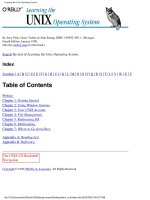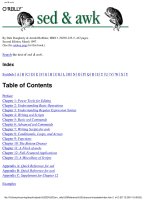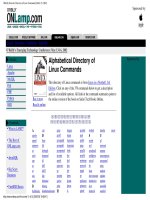o'reilly - linux networking cookbook nov 2007
Bạn đang xem bản rút gọn của tài liệu. Xem và tải ngay bản đầy đủ của tài liệu tại đây (4.5 MB, 640 trang )
Linux Networking Cookbook
™
Carla Schroder
Beijing
•
Cambridge
•
Farnham
•
Köln
•
Paris
•
Sebastopol
•
Taipei
•
Tokyo
Linux Networking Cookbook
™
by Carla Schroder
Copyright © 2008 O’Reilly Media, Inc. All rights reserved.
Printed in the United States of America.
Published by O’Reilly Media, Inc., 1005 Gravenstein Highway North, Sebastopol, CA 95472.
O’Reilly books may be purchased for educational, business, or sales promotional use. Online editions
are also available for most titles (safari.oreilly.com). For more information, contact our
corporate/institutional sales department: (800) 998-9938 or
Editor:
Mike Loukides
Production Editor:
Sumita Mukherji
Copyeditor:
Derek Di Matteo
Proofreader:
Sumita Mukherji
Indexer:
John Bickelhaupt
Cover Designer:
Karen Montgomery
Interior Designer:
David Futato
Illustrator:
Jessamyn Read
Printing History:
November 2007: First Edition.
Nutshell Handbook, the Nutshell Handbook logo, and the O’Reilly logo are registered trademarks of
O’Reilly Media, Inc. The Cookbook series designations, Linux Networking Cookbook, the image of a
female blacksmith, and related trade dress are trademarks of O’Reilly Media, Inc.
Java
™
is a trademark of Sun Microsystems, Inc. .NET is a registered trademark of Microsoft
Corporation.
Many of the designations used by manufacturers and sellers to distinguish their products are claimed as
trademarks. Where those designations appear in this book, and O’Reilly Media, Inc. was aware of a
trademark claim, the designations have been printed in caps or initial caps.
While every precaution has been taken in the preparation of this book, the publisher and author assume
no responsibility for errors or omissions, or for damages resulting from the use of the information
contained herein.
This book uses RepKover
™
, a durable and flexible lay-flat binding.
ISBN-10: 0-596-10248-8
ISBN-13: 978-0-596-10248-7
[M]
To Terry Hanson—thank you!
You make it all worthwhile.
Table of Contents
Preface
. . . . . . . . . . . . . . . . . . . . . . . . . . . . . . . . . . . . . . . . . . . . . . . . . . . . . . . . . . . . . . . .
xv
1. Introduction to Linux Networking
. . . . . . . . . . . . . . . . . . . . . . . . . . . . . . . . . . . .
1
1.0 Introduction 1
2. Building a Linux Gateway on a Single-Board Computer
. . . . . . . . . . . . . . . . .
12
2.0 Introduction 12
2.1 Getting Acquainted with the Soekris 4521 14
2.2 Configuring Multiple Minicom Profiles 17
2.3 Installing Pyramid Linux on a Compact Flash Card 17
2.4 Network Installation of Pyramid on Debian 19
2.5 Network Installation of Pyramid on Fedora 21
2.6 Booting Pyramid Linux 24
2.7 Finding and Editing Pyramid Files 26
2.8 Hardening Pyramid 27
2.9 Getting and Installing the Latest Pyramid Build 28
2.10 Adding Additional Software to Pyramid Linux 28
2.11 Adding New Hardware Drivers 32
2.12 Customizing the Pyramid Kernel 33
2.13 Updating the Soekris comBIOS 34
3. Building a Linux Firewall
. . . . . . . . . . . . . . . . . . . . . . . . . . . . . . . . . . . . . . . . . . .
36
3.0 Introduction 36
3.1 Assembling a Linux Firewall Box 44
3.2 Configuring Network Interface Cards on Debian 45
3.3 Configuring Network Interface Cards on Fedora 48
3.4 Identifying Which NIC Is Which 50
vi | Table of Contents
3.5 Building an Internet-Connection Sharing Firewall on a Dynamic
WAN IP Address 51
3.6 Building an Internet-Connection Sharing Firewall on a Static
WAN IP Address 56
3.7 Displaying the Status of Your Firewall 57
3.8 Turning an iptables Firewall Off 58
3.9 Starting iptables at Boot, and Manually Bringing Your Firewall
Up and Down 59
3.10 Testing Your Firewall 62
3.11 Configuring the Firewall for Remote SSH Administration 65
3.12 Allowing Remote SSH Through a NAT Firewall 66
3.13 Getting Multiple SSH Host Keys Past NAT 68
3.14 Running Public Services on Private IP Addresses 69
3.15 Setting Up a Single-Host Firewall 71
3.16 Setting Up a Server Firewall 76
3.17 Configuring iptables Logging 79
3.18 Writing Egress Rules 80
4. Building a Linux Wireless Access Point
. . . . . . . . . . . . . . . . . . . . . . . . . . . . . . . .
82
4.0 Introduction 82
4.1 Building a Linux Wireless Access Point 86
4.2 Bridging Wireless to Wired 87
4.3 Setting Up Name Services 90
4.4 Setting Static IP Addresses from the DHCP Server 93
4.5 Configuring Linux and Windows Static DHCP Clients 94
4.6 Adding Mail Servers to dnsmasq 96
4.7 Making WPA2-Personal Almost As Good As WPA-Enterprise 97
4.8 Enterprise Authentication with a RADIUS Server 100
4.9 Configuring Your Wireless Access Point to Use FreeRADIUS 104
4.10 Authenticating Clients to FreeRADIUS 106
4.11 Connecting to the Internet and Firewalling 107
4.12 Using Routing Instead of Bridging 108
4.13 Probing Your Wireless Interface Card 113
4.14 Changing the Pyramid Router’s Hostname 114
4.15 Turning Off Antenna Diversity 115
4.16 Managing dnsmasq’s DNS Cache 117
4.17 Managing Windows’ DNS Caches 120
4.18 Updating the Time at Boot 121
Table of Contents | vii
5. Building a VoIP Server with Asterisk
. . . . . . . . . . . . . . . . . . . . . . . . . . . . . . . .
123
5.0 Introduction 123
5.1 Installing Asterisk from Source Code 127
5.2 Installing Asterisk on Debian 131
5.3 Starting and Stopping Asterisk 132
5.4 Testing the Asterisk Server 135
5.5 Adding Phone Extensions to Asterisk and Making Calls 136
5.6 Setting Up Softphones 143
5.7 Getting Real VoIP with Free World Dialup 146
5.8 Connecting Your Asterisk PBX to Analog Phone Lines 148
5.9 Creating a Digital Receptionist 151
5.10 Recording Custom Prompts 153
5.11 Maintaining a Message of the Day 156
5.12 Transferring Calls 158
5.13 Routing Calls to Groups of Phones 158
5.14 Parking Calls 159
5.15 Customizing Hold Music 161
5.16 Playing MP3 Sound Files on Asterisk 161
5.17 Delivering Voicemail Broadcasts 162
5.18 Conferencing with Asterisk 163
5.19 Monitoring Conferences 165
5.20 Getting SIP Traffic Through iptables NAT Firewalls 166
5.21 Getting IAX Traffic Through iptables NAT Firewalls 168
5.22 Using AsteriskNOW, “Asterisk in 30 Minutes” 168
5.23 Installing and Removing Packages on AsteriskNOW 170
5.24 Connecting Road Warriors and Remote Users 171
6. Routing with Linux
. . . . . . . . . . . . . . . . . . . . . . . . . . . . . . . . . . . . . . . . . . . . . . .
173
6.0 Introduction 173
6.1 Calculating Subnets with ipcalc 176
6.2 Setting a Default Gateway 178
6.3 Setting Up a Simple Local Router 180
6.4 Configuring Simplest Internet Connection Sharing 183
6.5 Configuring Static Routing Across Subnets 185
6.6 Making Static Routes Persistent 186
6.7 Using RIP Dynamic Routing on Debian 187
6.8 Using RIP Dynamic Routing on Fedora 191
6.9 Using Quagga’s Command Line 192
viii | Table of Contents
6.10 Logging In to Quagga Daemons Remotely 194
6.11 Running Quagga Daemons from the Command Line 195
6.12 Monitoring RIPD 197
6.13 Blackholing Routes with Zebra 198
6.14 Using OSPF for Simple Dynamic Routing 199
6.15 Adding a Bit of Security to RIP and OSPF 201
6.16 Monitoring OSPFD 202
7. Secure Remote Administration with SSH
. . . . . . . . . . . . . . . . . . . . . . . . . . . . .
204
7.0 Introduction 204
7.1 Starting and Stopping OpenSSH 207
7.2 Creating Strong Passphrases 208
7.3 Setting Up Host Keys for Simplest Authentication 209
7.4 Generating and Copying SSH Keys 211
7.5 Using Public-Key Authentication to Protect System Passwords 213
7.6 Managing Multiple Identity Keys 214
7.7 Hardening OpenSSH 215
7.8 Changing a Passphrase 216
7.9 Retrieving a Key Fingerprint 217
7.10 Checking Configuration Syntax 218
7.11 Using OpenSSH Client Configuration Files for Easier Logins 218
7.12 Tunneling X Windows Securely over SSH 220
7.13 Executing Commands Without Opening a Remote Shell 221
7.14 Using Comments to Label Keys 222
7.15 Using DenyHosts to Foil SSH Attacks 223
7.16 Creating a DenyHosts Startup File 225
7.17 Mounting Entire Remote Filesystems with sshfs 226
8. Using Cross-Platform Remote Graphical Desktops
. . . . . . . . . . . . . . . . . . . . .
228
8.0 Introduction 228
8.1 Connecting Linux to Windows via rdesktop 230
8.2 Generating and Managing FreeNX SSH Keys 233
8.3 Using FreeNX to Run Linux from Windows 233
8.4 Using FreeNX to Run Linux from Solaris, Mac OS X, or Linux 238
8.5 Managing FreeNX Users 239
8.6 Watching Nxclient Users from the FreeNX Server 240
8.7 Starting and Stopping the FreeNX Server 241
Table of Contents | ix
8.8 Configuring a Custom Desktop 242
8.9 Creating Additional Nxclient Sessions 244
8.10 Enabling File and Printer Sharing, and Multimedia in Nxclient 246
8.11 Preventing Password-Saving in Nxclient 246
8.12 Troubleshooting FreeNX 247
8.13 Using VNC to Control Windows from Linux 248
8.14 Using VNC to Control Windows and Linux at the Same Time 250
8.15 Using VNC for Remote Linux-to-Linux Administration 252
8.16 Displaying the Same Windows Desktop to Multiple Remote Users 254
8.17 Changing the Linux VNC Server Password 256
8.18 Customizing the Remote VNC Desktop 257
8.19 Setting the Remote VNC Desktop Size 258
8.20 Connecting VNC to an Existing X Session 259
8.21 Securely Tunneling x11vnc over SSH 261
8.22 Tunneling TightVNC Between Linux and Windows 262
9. Building Secure Cross-Platform Virtual Private Networks
with OpenVPN
. . . . . . . . . . . . . . . . . . . . . . . . . . . . . . . . . . . . . . . . . . . . . . . . . . .
265
9.0 Introduction 265
9.1 Setting Up a Safe OpenVPN Test Lab 267
9.2 Starting and Testing OpenVPN 270
9.3 Testing Encryption with Static Keys 272
9.4 Connecting a Remote Linux Client Using Static Keys 274
9.5 Creating Your Own PKI for OpenVPN 276
9.6 Configuring the OpenVPN Server for Multiple Clients 279
9.7 Configuring OpenVPN to Start at Boot 281
9.8 Revoking Certificates 282
9.9 Setting Up the OpenVPN Server in Bridge Mode 284
9.10 Running OpenVPN As a Nonprivileged User 285
9.11 Connecting Windows Clients 286
10. Building a Linux PPTP VPN Server
. . . . . . . . . . . . . . . . . . . . . . . . . . . . . . . . . . .
287
10.0 Introduction 287
10.1 Installing Poptop on Debian Linux 290
10.2 Patching the Debian Kernel for MPPE Support 291
10.3 Installing Poptop on Fedora Linux 293
10.4 Patching the Fedora Kernel for MPPE Support 294
10.5 Setting Up a Standalone PPTP VPN Server 295
x | Table of Contents
10.6 Adding Your Poptop Server to Active Directory 298
10.7 Connecting Linux Clients to a PPTP Server 299
10.8 Getting PPTP Through an iptables Firewall 300
10.9 Monitoring Your PPTP Server 301
10.10 Troubleshooting PPTP 302
11. Single Sign-on with Samba for Mixed Linux/Windows LANs
. . . . . . . . . . . .
305
11.0 Introduction 305
11.1 Verifying That All the Pieces Are in Place 307
11.2 Compiling Samba from Source Code 310
11.3 Starting and Stopping Samba 312
11.4 Using Samba As a Primary Domain Controller 313
11.5 Migrating to a Samba Primary Domain Controller from an
NT4 PDC 317
11.6 Joining Linux to an Active Directory Domain 319
11.7 Connecting Windows 95/98/ME to a Samba Domain 323
11.8 Connecting Windows NT4 to a Samba Domain 324
11.9 Connecting Windows NT/2000 to a Samba Domain 325
11.10 Connecting Windows XP to a Samba Domain 325
11.11 Connecting Linux Clients to a Samba Domain with
Command-Line Programs 326
11.12 Connecting Linux Clients to a Samba Domain with
Graphical Programs 330
12. Centralized Network Directory with OpenLDAP
. . . . . . . . . . . . . . . . . . . . . . .
332
12.0 Introduction 332
12.1 Installing OpenLDAP on Debian 339
12.2 Installing OpenLDAP on Fedora 341
12.3 Configuring and Testing the OpenLDAP Server 341
12.4 Creating a New Database on Fedora 344
12.5 Adding More Users to Your Directory 348
12.6 Correcting Directory Entries 350
12.7 Connecting to a Remote OpenLDAP Server 352
12.8 Finding Things in Your OpenLDAP Directory 352
12.9 Indexing Your Database 354
12.10 Managing Your Directory with Graphical Interfaces 356
12.11 Configuring the Berkeley DB 358
12.12 Configuring OpenLDAP Logging 363
Table of Contents | xi
12.13 Backing Up and Restoring Your Directory 364
12.14 Refining Access Controls 366
12.15 Changing Passwords 370
13. Network Monitoring with Nagios
. . . . . . . . . . . . . . . . . . . . . . . . . . . . . . . . . . .
371
13.0 Introduction 371
13.1 Installing Nagios from Sources 372
13.2 Configuring Apache for Nagios 376
13.3 Organizing Nagios’ Configuration Files Sanely 378
13.4 Configuring Nagios to Monitor Localhost 380
13.5 Configuring CGI Permissions for Full Nagios Web Access 389
13.6 Starting Nagios at Boot 390
13.7 Adding More Nagios Users 391
13.8 Speed Up Nagios with check_icmp 392
13.9 Monitoring SSHD 393
13.10 Monitoring a Web Server 397
13.11 Monitoring a Mail Server 400
13.12 Using Servicegroups to Group Related Services 402
13.13 Monitoring Name Services 403
13.14 Setting Up Secure Remote Nagios Administration with OpenSSH 405
13.15 Setting Up Secure Remote Nagios Administration with OpenSSL 406
14. Network Monitoring with MRTG
. . . . . . . . . . . . . . . . . . . . . . . . . . . . . . . . . . . .
408
14.0 Introduction 408
14.1 Installing MRTG 409
14.2 Configuring SNMP on Debian 410
14.3 Configuring SNMP on Fedora 413
14.4 Configuring Your HTTP Service for MRTG 413
14.5 Configuring and Starting MRTG on Debian 415
14.6 Configuring and Starting MRTG on Fedora 418
14.7 Monitoring Active CPU Load 419
14.8 Monitoring CPU User and Idle Times 422
14.9 Monitoring Physical Memory 424
14.10 Monitoring Swap Space and Memory 425
14.11 Monitoring Disk Usage 426
14.12 Monitoring TCP Connections 428
14.13 Finding and Testing MIBs and OIDs 429
14.14 Testing Remote SNMP Queries 430
xii | Table of Contents
14.15 Monitoring Remote Hosts 432
14.16 Creating Multiple MRTG Index Pages 433
14.17 Running MRTG As a Daemon 434
15. Getting Acquainted with IPv6
. . . . . . . . . . . . . . . . . . . . . . . . . . . . . . . . . . . . . .
437
15.0 Introduction 437
15.1 Testing Your Linux System for IPv6 Support 442
15.2 Pinging Link Local IPv6 Hosts 443
15.3 Setting Unique Local Unicast Addresses on Interfaces 445
15.4 Using SSH with IPv6 446
15.5 Copying Files over IPv6 with scp 447
15.6 Autoconfiguration with IPv6 448
15.7 Calculating IPv6 Addresses 449
15.8 Using IPv6 over the Internet 450
16. Setting Up Hands-Free Network Installations of New Systems
. . . . . . . . . .
452
16.0 Introduction 452
16.1 Creating Network Installation Boot Media for Fedora Linux 453
16.2 Network Installation of Fedora Using Network Boot Media 455
16.3 Setting Up an HTTP-Based Fedora Installation Server 457
16.4 Setting Up an FTP-Based Fedora Installation Server 458
16.5 Creating a Customized Fedora Linux Installation 461
16.6 Using a Kickstart File for a Hands-off Fedora Linux Installation 463
16.7 Fedora Network Installation via PXE Netboot 464
16.8 Network Installation of a Debian System 466
16.9 Building a Complete Debian Mirror with apt-mirror 468
16.10 Building a Partial Debian Mirror with apt-proxy 470
16.11 Configuring Client PCs to Use Your Local Debian Mirror 471
16.12 Setting Up a Debian PXE Netboot Server 472
16.13 Installing New Systems from Your Local Debian Mirror 474
16.14 Automating Debian Installations with Preseed Files 475
17. Linux Server Administration via Serial Console
. . . . . . . . . . . . . . . . . . . . . . .
478
17.0 Introduction 478
17.1 Preparing a Server for Serial Console Administration 479
17.2 Configuring a Headless Server with LILO 483
17.3 Configuring a Headless Server with GRUB 485
17.4 Booting to Text Mode on Debian 487
Table of Contents | xiii
17.5 Setting Up the Serial Console 489
17.6 Configuring Your Server for Dial-in Administration 492
17.7 Dialing In to the Server 495
17.8 Adding Security 496
17.9 Configuring Logging 497
17.10 Uploading Files to the Server 498
18. Running a Linux Dial-Up Server
. . . . . . . . . . . . . . . . . . . . . . . . . . . . . . . . . . . . .
501
18.0 Introduction 501
18.1 Configuring a Single Dial-Up Account with WvDial 501
18.2 Configuring Multiple Accounts in WvDial 504
18.3 Configuring Dial-Up Permissions for Nonroot Users 505
18.4 Creating WvDial Accounts for Nonroot Users 507
18.5 Sharing a Dial-Up Internet Account 508
18.6 Setting Up Dial-on-Demand 509
18.7 Scheduling Dial-Up Availability with cron 510
18.8 Dialing over Voicemail Stutter Tones 512
18.9 Overriding Call Waiting 512
18.10 Leaving the Password Out of the Configuration File 513
18.11 Creating a Separate pppd Logfile 514
19. Troubleshooting Networks
. . . . . . . . . . . . . . . . . . . . . . . . . . . . . . . . . . . . . . . . .
515
19.0 Introduction 515
19.1 Building a Network Diagnostic and Repair Laptop 516
19.2 Testing Connectivity with ping 519
19.3 Profiling Your Network with FPing and Nmap 521
19.4 Finding Duplicate IP Addresses with arping 523
19.5 Testing HTTP Throughput and Latency with httping 525
19.6 Using traceroute, tcptraceroute, and mtr to Pinpoint Network
Problems 527
19.7 Using tcpdump to Capture and Analyze Traffic 529
19.8 Capturing TCP Flags with tcpdump 533
19.9 Measuring Throughput, Jitter, and Packet Loss with iperf 535
19.10 Using ngrep for Advanced Packet Sniffing 538
19.11 Using ntop for Colorful and Quick Network Monitoring 540
19.12 Troubleshooting DNS Servers 542
19.13 Troubleshooting DNS Clients 545
19.14 Troubleshooting SMTP Servers 546
xiv | Table of Contents
19.15 Troubleshooting a POP3, POP3s, or IMAP Server 549
19.16 Creating SSL Keys for Your Syslog-ng Server on Debian 551
19.17 Creating SSL Keys for Your Syslog-ng Server on Fedora 557
19.18 Setting Up stunnel for Syslog-ng 558
19.19 Building a Syslog Server 560
A. Essential References
. . . . . . . . . . . . . . . . . . . . . . . . . . . . . . . . . . . . . . . . . . . . . .
563
B. Glossary of Networking Terms
. . . . . . . . . . . . . . . . . . . . . . . . . . . . . . . . . . . . . .
566
C. Linux Kernel Building Reference
. . . . . . . . . . . . . . . . . . . . . . . . . . . . . . . . . . . .
590
Index
. . . . . . . . . . . . . . . . . . . . . . . . . . . . . . . . . . . . . . . . . . . . . . . . . . . . . . . . . . . . . . . . .
599
xv
Preface
So there you are, staring at your computer and wondering why your Internet connec-
tion is running slower than slow, and wishing you knew enough to penetrate the
endless runaround you get from your service provider. Or, you’re the Lone IT Staffer
in a small business who got the job because you know the difference between a
switch and hub, and now you’re supposed to have all the answers. Or, you’re really
interested in networking, and want to learn more and make it your profession. Or,
you are already knowledgeable, and you simply have a few gaps you need to fill. But
you’re finding out that computer networking is a subject with reams and reams of
reference material that is not always organized in a coherent, useful order, and it
takes an awful lot of reading just to figure out which button to push.
To make things even more interesting, you need to integrate Linux and Windows
hosts. If you want to pick up a book that lays out the steps for specific tasks, that
explains clearly the necessary commands and configurations, and does not tax your
patience with endless ramblings and meanderings into theory and obscure RFCs, this
is the book for you.
Audience
Ideally, you will have some Linux experience. You should know how to install and
remove programs, navigate the filesystem, manage file permissions, and user and
group creation. You should have some exposure to TCP/IP and Ethernet basics, IPv4
and IPv6, LAN, WAN, subnet, router, firewall, gateway, switch, hub, and cabling. If
you are starting from scratch, there are any number of introductory books to get you
up to speed on the basics.
xvi
|
Preface
If you don’t already have basic Linux experience, I recommend getting the Linux
Cookbook (O’Reilly). The Linux Cookbook (which I authored) was designed as a
companion book to this one. It covers installing and removing software, user
account management, cross-platform file and printer sharing, cross-platform user
authentication, running servers (e.g., mail, web, DNS), backup and recovery,
system rescue and repair, hardware discovery, configuring X Windows, remote
administration, and lots more good stuff.
The home/SOHO user also will find some useful chapters in this book, and anyone
who wants to learn Linux networking will be able to do everything in this book with
a couple of ordinary PCs and inexpensive networking hardware.
Contents of This Book
This book is broken into 19 chapters and 3 appendixes:
Chapter 1, Introduction to Linux Networking
This is your high-level view of computer networking, covering cabling, routing
and switching, interfaces, the different types of Internet services, and the funda-
mentals of network architecture and performance.
Chapter 2, Building a Linux Gateway on a Single-Board Computer
In which we are introduced to the fascinating and adaptable world of Linux on
routerboards, such as those made by Soekris and PC Engines, and how Linux on
one of these little boards gives you more power and flexibility than commercial
gear costing many times as much.
Chapter 3, Building a Linux Firewall
Learn to use Linux’s powerful iptables packet filter to protect your network, with
complete recipes for border firewalls, single-host firewalls, getting services
through NAT (Network Address Translation), blocking external access to inter-
nal services, secure remote access through your firewall, and how to safely test
new firewalls before deploying them on production systems.
Chapter 4, Building a Linux Wireless Access Point
You can use Linux and a routerboard (or any ordinary PC hardware) to build a
secure, powerful, fully featured wireless access point customized to meet your
needs, including state-of-the-art authentication and encryption, name services,
and routing and bridging.
Chapter 5, Building a VoIP Server with Asterisk
This chapter digs into the very guts of the revolutionary and popular Asterisk
VoIP server. Sure, these days, everyone has pretty point-and-click GUIs for man-
aging their iPBX systems, but you still need to understand what’s under the
hood. This chapter shows you how to install Asterisk and configure Asterisk
Preface
|
xvii
from scratch: how to create user’s extensions and voicemail, manage custom
greetings and messages, do broadcast voicemails, provision phones, set up a dig-
ital receptionist, do PSTN (Public Switched Telephone Network) integration, do
pure VoIP, manage road warriors, and more.
Chapter 6, Routing with Linux
Linux’s networking stack is a powerhouse, and it includes advanced routing
capabilities. Here be recipes for building Linux-based routers, calculating
subnets (accurately and without pain), blackholing unwelcome visitors, using
static and dynamic routing, and for monitoring your hard-working little routers.
Chapter 7, Secure Remote Administration with SSH
OpenSSH is an amazing and endlessly useful implementation of the very secure
SSH protocol. It supports traditional password-based logins, password-less
public-key-based logins, and securely carries traffic over untrusted networks.
You’ll learn how to do all of this, plus how to safely log in to your systems
remotely, and how to harden and protect OpenSSH itself.
Chapter 8, Using Cross-Platform Remote Graphical Desktops
OpenSSH is slick and quick, and offers both text console and a secure X
Windows tunnel for running graphical applications. There are several excellent
programs (FreeNX, rdesktop, and VNC) that offer a complementary set of capa-
bilities, such as remote helpdesk, your choice of remote desktops, and Linux as a
Windows terminal server client. You can control multiple computers from a sin-
gle keyboard and monitor, and even conduct a class where multiple users view
or participate in the same remote session.
Chapter 9, Building Secure Cross-Platform Virtual Private Networks with OpenVPN
Everyone seems to want a secure, user-friendly VPN (Virtual Private Network).
But there is a lot of confusion over what a VPN really is, and a lot of commercial
products that are not true VPNs at all, but merely SSL portals to a limited num-
ber of services. OpenVPN is a true SSL-based VPN that requires all endpoints to
be trusted, and that uses advanced methods for securing the connection and
keeping it securely encrypted. OpenVPN includes clients for Linux, Solaris, Mac
OS X, OpenBSD, FreeBSD, and NetBSD, so it’s your one-stop VPN shop. You’ll
learn how to create and manage your own PKI (Public Key Infrastructure), which
is crucial for painless OpenVPN administration. And, you’ll learn how to safely
test OpenVPN, how to set up the server, and how to connect clients.
Chapter 10, Building a Linux PPTP VPN Server
This chapter covers building and configuring a Linux PPTP VPN server for
Windows and Linux clients; how to patch Windows clients so they have the nec-
essary encryption support, how to integrate with Active Directory, and how to
get PPTP through an iptables firewall.
xviii
|
Preface
Chapter 11, Single Sign-on with Samba for Mixed Linux/Windows LANs
Using Samba as a Windows NT4-style domain controller gives you a flexible,
reliable, inexpensive mechanism for authenticating your network clients. You’ll
learn how to migrate from a Windows domain controller to Samba on Linux,
how to migrate Windows user accounts to Samba, integrate Linux clients with
Active Directory, and how to connect clients.
Chapter 12, Centralized Network Directory with OpenLDAP
An LDAP directory is an excellent mechanism on which to base your network
directory services. This chapter shows how to build an OpenLDAP directory
from scratch, how to test it, how to make changes, how to find things, how to
speed up lookups with smart indexing, and how to tune it for maximum
performance.
Chapter 13, Network Monitoring with Nagios
Nagios is a great network monitoring system that makes clever use of standard
Linux commands to monitor services and hosts, and to alert you when there are
problems. Status reports are displayed in nice colorful graphs on HTML pages
that can be viewed on any Web browser. Learn to monitor basic system health,
and common servers like DNS, Web, and mail servers, and how to perform
secure remote Nagios administration.
Chapter 14, Network Monitoring with MRTG
MRTG is an SNMP-aware network monitor, so theoretically it can be adapted to
monitor any SNMP-enabled device or service. Learn how to monitor hardware
and services, and how to find the necessary SNMP information to create custom
monitors.
Chapter 15, Getting Acquainted with IPv6
Ready or not, IPv6 is coming, and it will eventually supplant IPv4. Get ahead of
the curve by running IPv6 on your own network and over the Internet; learn why
those very long IPv6 addresses are actually simpler to manage than IPv4
addresses; learn how to use SSH over IPv6, and how to auto-configure clients
without DHCP.
Chapter 16, Setting Up Hands-Free Network Installations of New Systems
Fedora Linux and all of its relatives (Red Hat, CentOS, Mandriva, PC Linux OS,
and so forth), and Debian Linux and all of its descendants (Ubuntu, Mepis,
Knoppix, etc.) include utilities for creating and cloning customized installations,
and for provisioning new systems over the network. So, you can plug-in a PC,
and within a few minutes have a complete new installation all ready to go. This
chapter describes how to use ordinary installation ISO images for network instal-
lations of Fedora, and how to create and maintain complete local Debian mirrors
efficiently.
Preface
|
xix
Chapter 17, Linux Server Administration via Serial Console
When Ethernet goes haywire, the serial console will save the day, both locally
and remotely; plus, routers and managed switches are often administered via the
serial console. Learn how to set up any Linux computer to accept serial
connections, and how to use any Linux, Mac OS X, or Windows PC as a serial
terminal. You’ll also learn how to do dial-up server administration, and how to
upload files over your serial link.
Chapter 18, Running a Linux Dial-Up Server
Even in these modern times, dial-up networking is still important; we’re a long
way from universal broadband. Set up Internet-connection sharing over dial-up,
dial-on-demand, use cron to schedule dialup sessions, and set up multiple dial-
up accounts.
Chapter 19, Troubleshooting Networks
Linux contains a wealth of power tools for diagnosing and fixing network
problems. You’ll learn the deep dark secrets of ping, how to use tcpdump and
Wireshark to eavesdrop on your own wires, how to troubleshoot the name and
mail server, how to discover all the hosts on your network, how to track prob-
lems down to their sources, and how to set up a secure central logging server.
You’ll learn a number of lesser-known but powerful utilities such as fping,
httping, arping, and mtr, and how to transform an ordinary old laptop into your
indispensible portable network diagnostic-and-fixit tool.
Appendix A, Essential References
Computer networking is a large and complex subject, so here is a list of books
and other references that tell you what you need to know.
Appendix B, Glossary of Networking Terms
Don’t know what it means? Look it up here.
Appendix C, Linux Kernel Building Reference
As the Linux kernel continues to expand in size and functionality, it often makes
sense to build your own kernel with all the unnecessary bits stripped out. Learn
the Fedora way, the Debian way, and the vanilla way of building a custom
kernel.
What Is Included
This book covers both old standbys and newfangled technologies. The old-time stuff
includes system administration via serial console, dial-up networking, building an
Internet gateway, VLANs, various methods of secure remote access, routing, and
traffic control. Newfangled technologies include building your own iPBX with Aster-
isk, wireless connectivity, cross-platform remote graphical desktops, hands-free
network installation of new systems, single sign-on for mixed Linux and Windows
LANs, and IPv6 basics. And, there are chapters on monitoring, alerting, and
troubleshooting.
xx
|
Preface
Which Linux Distributions Are Used in the Book
There are literally hundreds, if not thousands of Linux distributions: live distribu-
tions on all kinds of bootable media, from business-card CDs to USB keys to CDs to
DVDs; large general-purpose distributions; tiny specialized distributions for fire-
walls, routers, and old PCs; multimedia distributions; scientific distributions; cluster
distributions; distributions that run Windows applications; and super-secure distri-
butions. There is no way to even begin to cover all of these; fortunately for frazzled
authors, the Linux world can be roughly divided into two camps: Red Hat Linux and
Debian Linux. Both are fundamental, influential distributions that have spawned the
majority of derivatives and clones.
In this book, the Red Hat world is represented by Fedora Linux, the free community-
driven distribution sponsored by Red Hat. Fedora is free of cost, the core
distribution contains only Free Software, and it has a more rapid release cycle than
Red Hat Enterprise Linux (RHEL). RHEL is on an 18-month release cycle, is
designed to be stable and predictable, and has no packaged free-of-cost version,
though plenty of free clones abound. The clones are built from the RHEL SRPMs,
with the Red Hat trademarks removed. Some RHEL-based distributions include
CentOS, White Box Linux, Lineox, White Box Enterprise Linux, Tao Linux, and Pie
Box Linux.
Additionally, there are a number of Red Hat derivatives to choose from, like Man-
driva and PCLinuxOS. The recipes for Fedora should work for all of these, though
you might find some small differences in filenames, file locations, and package
names.
Debian-based distributions are multiplying even as we speak: Ubuntu, Kubuntu,
Edubuntu, Xandros, Mepis, Knoppix, Kanotix, and Linspire, to name but a few.
While all of these have their own enhancements and modifications, package manage-
ment with aptitude or Synaptic works the same on all of them.
Novell/SUSE is RPM-based like Red Hat, but has always gone its own way. Gentoo
and Slackware occupy their own unique niches. I’m not even going to try to include
all of these, so users of these distributions are on their own. Fortunately, each of
these is very well-documented and have active, helpful user communities, and
they’re not that different from their many cousins.
Downloads and Feedback
Doubtless this book, despite the heroic efforts of me and the fabulous O’Reilly team,
contains flaws, errors, and omissions. Please email your feedback and suggestions to
, so we can make the second edition even better. Be sure
to visit for errata, updates, and to
download the scripts used in the book.
Preface
|
xxi
Conventions
Italic
Used for pathnames, filenames, program names, Internet addresses, such as
domain names and URLs, and new terms where they are defined.
Constant Width
Used for output from programs, and names and keywords in examples.
Constant Width Italic
Used for replaceable parameters or optional elements when showing a com-
mand’s syntax.
Constant Width Bold
Used for commands that should be typed verbatim, and for emphasis within
program code and configuration files.
Unix/Linux commands that can be typed by a regular user are preceded with a regu-
lar prompt, ending with
$. Commands that must be typed as root are preceded with
a “root” prompt, ending with a
#. In real life, it is better to use the sudo command
wherever possible to avoid logging in as root. Both kinds of prompts indicate the
username, the current host, and the current working directory (for example:
root@xena:/var/llibtftpboot #).
This icon signifies a tip, suggestion, or general note.
This icon indicates a warning or caution.
Using Code Examples
This book is here to help you get your job done. In general, you may use the code in
this book in your programs and documentation. You do not need to contact us for
permission unless you’re reproducing a significant portion of the code. For example,
writing a program that uses several chunks of code from this book does not require
permission. Selling or distributing a CD-ROM of examples from O’Reilly books does
require permission. Answering a question by citing this book and quoting example
code does not require permission. Incorporating a significant amount of example
code from this book into your product’s documentation does require permission.
We appreciate, but do not require, attribution. An attribution usually includes the
title, author, publisher, and ISBN. For example: “Linux Networking Cookbook,by
Carla Schroder. Copyright 2008 O’Reilly Media, Inc., 978-0-596-10248-7.”
xxii
|
Preface
If you feel your use of code examples falls outside fair use or the permission given
above, feel free to contact us at
Comments and Questions
Please address comments and questions concerning this book to the publisher:
O’Reilly Media, Inc.
1005 Gravenstein Highway North
Sebastopol, CA 95472
800-998-9938 (in the United States or Canada)
707-829-0515 (international or local)
707-829-0104 (fax)
We have a web page for this book, where we list errata, examples, and any addi-
tional information. You can access this page at:
/>To comment or ask technical questions about this book, send email to:
For more information about our books, conferences, Resource Centers, and the
O’Reilly Network, see the web site:
Safari® Books Online
When you see a Safari® Books Online icon on the cover of your
favorite technology book, that means the book is available online
through the O’Reilly Network Safari Bookshelf.
Safari offers a solution that’s better than e-books. It’s a virtual library that lets you
easily search thousands of top tech books, cut and paste code samples, download
chapters, and find quick answers when you need the most accurate, current informa-
tion. Try it for free at .
Preface
|
xxiii
Acknowledgments
Writing a book like this is a massive team effort. Special thanks go to my editor,
Mike Loukides. It takes unrelenting patience, tact, good taste, persistence, and an
amazing assortment of geek skills to shepherd a book like this to completion. Well
done and thank you. Also thanks to:
James Lopeman
Dana Sibera
Kristian Kielhofner
Ed Sawicki
Dana Sibera
Gerald Carter
Michell Murrain
Jamesha Fisher
Carol Williams
Rudy Zijlstra
Maria Blackmore
Meredydd Luff
Devdas Bhagat
Akkana Peck
Valorie Henson
Jennifer Scalf
Sander Marechal
Mary Gardiner
Conor Daly
Alvin Goats
Dragan Stanojevi -Nevidljvl









